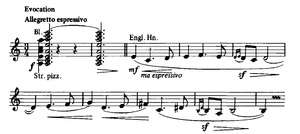Symphony No. 3 (Brahms)
 |
Symphony No. 3 in F major Op. 90 - I. Allegro con brio (10:05)
Symphony No. 3 in F major Op. 90 - II. Andante (8:07)
Symphony No. 3 in F major Op. 90 - III. Poco allegretto (6:10)
|
| Problems playing these files? See media help. | |
The Symphony No. 3 in F major, Op. 90, is a symphony by Johannes Brahms. The work was written in the summer of 1883 at Wiesbaden, nearly six years after he completed his Second Symphony. In the interim Brahms had written some of his greatest works, including the Violin Concerto, two overtures (Tragic Overture and Academic Festival Overture), and the Second Piano Concerto.
The premiere performance was given on 2 December 1883 by the Vienna Philharmonic Orchestra, under the direction of Hans Richter. It is the shortest of Brahms' four symphonies; a typical performance lasts between 30 and 40 minutes.
Instrumentation
The symphony is scored for two flutes, two oboes, two clarinets, two bassoons, a contrabassoon, four horns, two trumpets, three trombones, timpani, and strings.
Form




The symphony consists of four movements, marked as follows:
- Allegro con brio (F major), in sonata form.
- Andante (C major), in a modified sonata form.
- Poco allegretto (C minor), in ternary form (A B A').
- Allegro – Un poco sostenuto (F minor – F major), in a modified sonata form.
History
Hans Richter, who conducted the premiere of the symphony, proclaimed it to be Brahms' Eroica. The symphony was well received, more so than his Second Symphony. Although Richard Wagner had died earlier that year, the public feud between Brahms and Wagner had not yet subsided. Wagner enthusiasts tried to interfere with the symphony's premiere, and the conflict between the two factions nearly brought about a duel.[1]
After each performance, Brahms polished his score further, until it was published in May 1884. His friend the influential music critic Eduard Hanslick said, "Many music lovers will prefer the titanic force of the First Symphony; others, the untroubled charm of the Second, but the Third strikes me as being artistically the most nearly perfect."[1]
Musical elements
A musical motto consisting of three notes, F–A-flat–F, was significant to Brahms. In 1853 his friend Joseph Joachim had taken as his motto "Free, but lonely" (in German "Frei aber einsam"), and from the notes represented by the first letters of these words, F–A–E, Schumann, Brahms and Dietrich had jointly composed a violin sonata dedicated to Joachim. At the time of the Third Symphony, Brahms was a fifty-year-old bachelor who declared himself to be Frei aber froh, "Free but happy". His F–A–F motto, and some altered variations of it, can be heard throughout the symphony.[1]
At the beginning of the symphony the motto is the melody of the first three measures, and it is the bass line underlying the main theme in the next three. The motto persists, either boldly or disguised, as the melody or accompaniment throughout the movement. For the third movement – poco allegretto instead of the rapid scherzo standard in 19th-century symphony – Brahms created a unique kind of third movement that is moderate in tempo (poco allegretto) and intensely lyrical in character.[2] The finale is a lyrical, passionate movement, rich in melody that is intensely exploited, altered, and developed. The movement ends with reference to the motto heard in the first movement – one which quotes a motif heard in Schumann's Symphony No. 3, Rhenish in the first movement just before the second theme enters in the recapitulation – then fades away to a quiet ending.
See also
Notes
- 1 2 3 Leonard Burkat; liner notes for the 1998 recording (William Steinberg, conductor; Pittsburgh Symphony Orchestra; MCA Classics)
- ↑ Kamien, R. (2006). Johannes Brahms. In Music: An appreciation (9th ed., p. 352). McGraw-Hill Humanities.
References
- Frisch, Walter (2003). Brahms: The Four Symphonies. New Haven: Yale University Press. pp. 91–114. ISBN 978-0-300-09965-2.
External links
- Symphony No. 3: Scores at the International Music Score Library Project
- European archive Copyright-free LP recording of Brahms 3rd symphony by George Szell (conductor) and the Amsterdam Concertgebouw Orchestra (for non-American viewers only) at the European Archive.
- Visual analysis of Brahms' Symphony no. 3, first movement